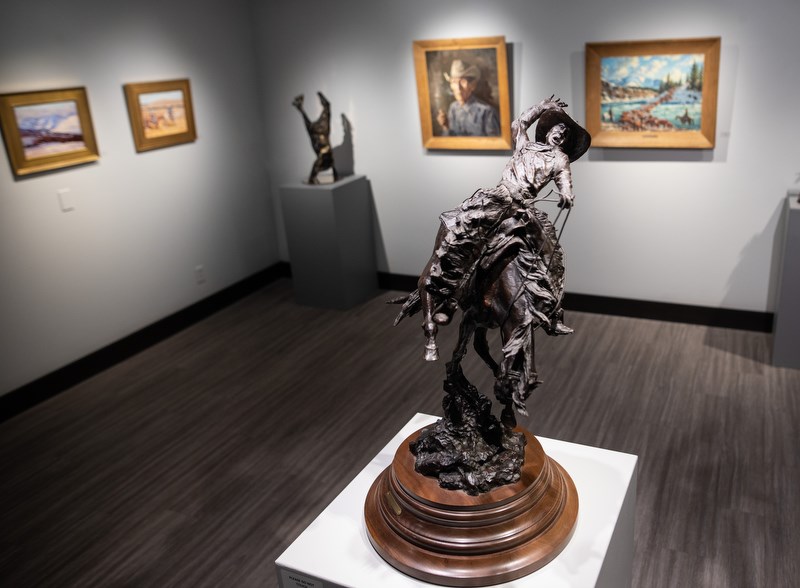Varying artistic perspectives of The West are on display in an Okotoks gallery for viewers to ponder over the next three months.
The Okotoks Art Gallery has put the works of 22 local artists together in a western showcase called On the Shoulders of Giants with pieces dating from the 1920s to 2019. They will remain on display in both galleries until Sept. 2.
Allan Boss, culture and heritage manager, worked with western art curator Brian Rusted, of Nanton, and Calgary art critic and curator Katherine Litalo to highlight western art produced by three generations of artists in the Foothills with perspectives ranging from contemporary to indigenous.
“The idea is to try and show the movement that has happened in the notion of western art going back to the early 1900s up through modern days,” said Boss. “We have amazing artists involved in this show, historical artists. What we’re showing is the path that western art has taken over the past years.”
The exhibit features more than 30 pieces by Dale Auger, Neepin Auger, Annora Brown, Bruno Canadien, Steve Coffey, Gaile Gallup, Roland Gissing, Steve Hoar, Bill Holder, Terrance Houle, Shannon Lawlor, M.J. (Mac) MacKenzie, Rosanna Marmont, Paul Rasporich, Kevin Rider, Rich Roenisch, Ted Schintz, Mandy Stobo, Bert Smith, Robert Spaith, Gerald Tailfeathers and Donna Wilson.
Rusted, chairman of University of Calgary’s faculty of art, said many people envision western art as depicting settlers, cowboys and ranching, but it’s so much more.
“Our goal was to look at people who really exemplify the conventions that characterize western art and then seek out people who were challenging those conventions or expanding them,” said Rusted. “It’s tying pieces of the regional history, but doing it with a pretty direct reference to the area.”
The exhibit wouldn’t be complete without references to ranching life, as is depicted by local painters and sculptors who spent hard days working at the infamous OH Ranch south of Longview.
Among them is 69-year-old retired rancher and avid painter Gaile Gallup, who lives northeast of Longview. Two of his oil paintings were selected for the show – one depicting a winter scene from his studio window and another of rancher friends Tom Bews and Don Kiemele moving yearlings west of the Bar U Ranch.
Gallup said ranching and painting have always been a part of his life.
“I enjoyed art as a child, - my mother was a painter,” he said. “When I was working on ranches as a young guy I was doing drawings - at that time mostly pen and ink. I was able to supplement my ranching income and sell a few of them.”
A graduate of the Alberta College of Art in Calgary, Gallup delved deeper into art since selling his cows in 2005 – although he never refuses lending a hand to friends requiring help moving cattle.
Most of Gallup’s subject matter, as one might suspect, relates to his ranching experiences.
Having it on display for people to enjoy, alongside pieces by Steve Hoar and Rich Roenisch, is an honour for Gallup.
“We rode together on the OH since about 1969,” he Gallup. “It means a lot to me because of the history, and the guys who worked with me more than anything. Things haven’t changed and we’re still doing it.”
Offering another perspective of the west is Black Diamond indigenous artist Bruno Canadien.
His art addresses issues surrounding First Nations sovereignty, resource exploitation and environmental concerns.
He presents them using mixed media collages, adornments, acrylic paints and drawings.
Inspired by his Dene Nation roots and concerns for the environment, Canadien utilizes acrylic paint, graphite and ribbons to depict topographical maps, floral imagery and wildlife.
“I bring all these elements together to make work that is more reflective of the complicated issues we have in regards to indigenous issues from a personal standpoint,” he said. “There’s also issues of land sovereignty, resource exploitation evidenced by my use of materials. For instance my acrylic paint and ribbons are petroleum based.”




